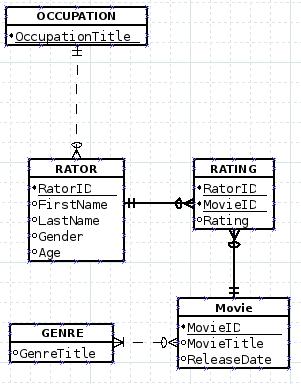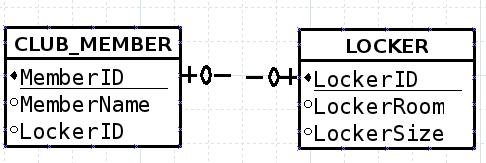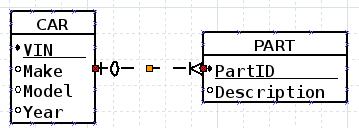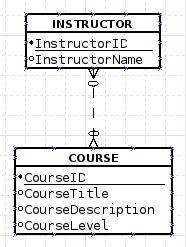Patterns in Forms, Reports and ER-Models
- But first, the diagram from last time.
-

- We will begin looking at some standard things that happen in database design.
- We will call these patterns.
- 1:1 Strong Entity Relationships
- Example: lockers in a sports club as they relate to customers
| Customer ID | Locker Number |
|---|
C-100 | L-001 |
C-101 | L-201 |
C-102 | L-022 |
- Lockers exist without customers.
- Customers exist without lockers.
- Each customer has (at most) one locker
- Each locker has (at most) one customer
- But there may be empty lockers, and there may be customers who don't want a locker.
- This is a strong relationship.
-

- The big question here seems to be, Is the relationship optional or mandatory?
- 1:n Strong Entity Relationships
- Book's example is bad: Departments within a company.
- How about parts and a car.
- Think of this as a junkyard database.
- They have a bunch of cars sitting around for parts.
- They also have some parts on the shelf.
- There are also some hulks sitting around with no usable parts.
- A car has many parts.
- A part is only on one car, but it might not be on any
- A part can not be on more than one car.
- This is strong since both a car and a part may exist without each other)
-

- N:M strong entity relationship
- A instructor course relationship.
- We have a list of courses.
- We have a list of instructors.
- Many different instructors may teach a given course (qualified, not assigned)
- An instructor is qualified to teach many different courses (qualified not assigned)
-

- ID-Dependent Relationships: Association pattern.
- Look at the table on the bottom of 173.
- We have parts (name, price, ...)
- We have suppliers
- But we assume the price from the supplier might change.
- So we have a third entity, the quotation.
- QUOTATION(PartNumber,SupplierID,Price)
- QUOTATION is in a weak relation to both part and supplier.
- Some companies might not supply a particular part. (So they will not have a quote)
- But we need at least one company to sell us any given part. (But more may)
- The price of a part from a company might change over time (so there will be possible multiple quotes from the same company)
- But we need at least one quote per part.
- The Multivalued attribute Pattern.
- Consider the university course list.
- Each instructor can be assigned to a class
- Each class has at least one instructor (But there may be more than one)
- A class CAN NOT exist without an instructor.
- So this is a weak relationship.



